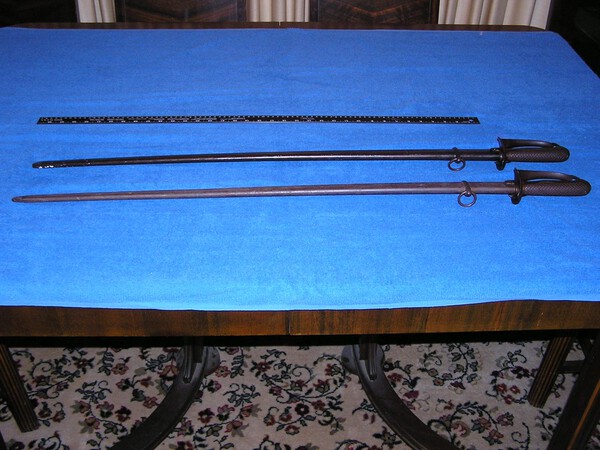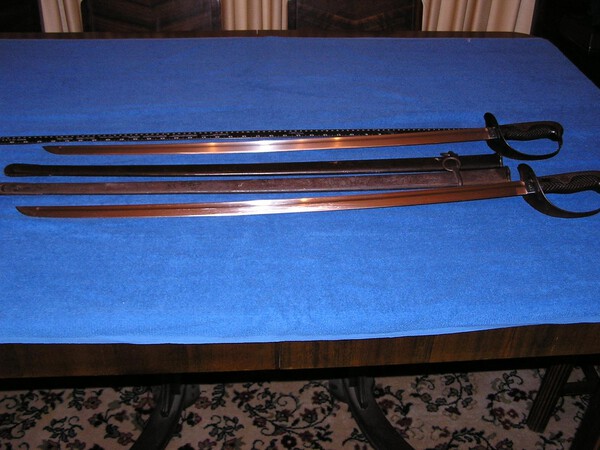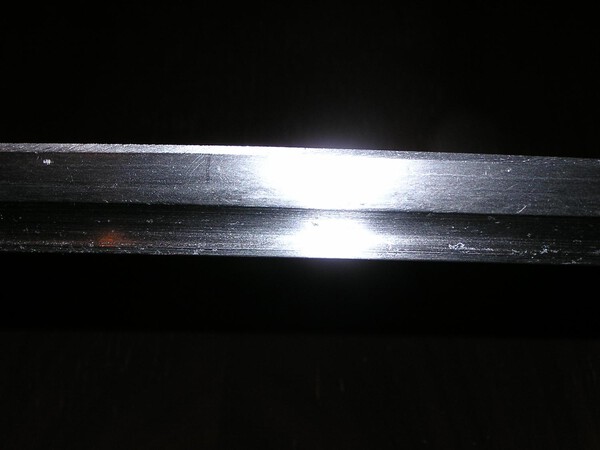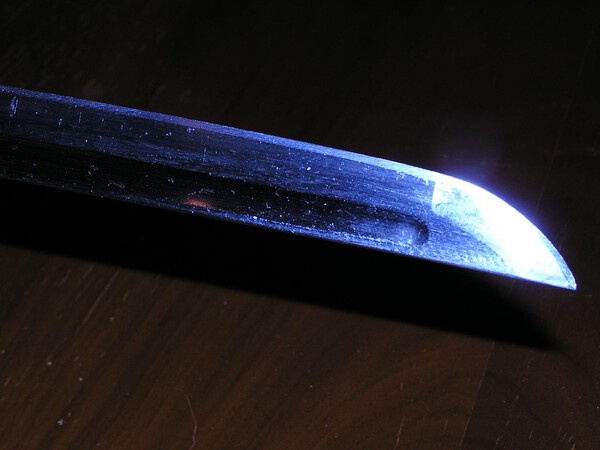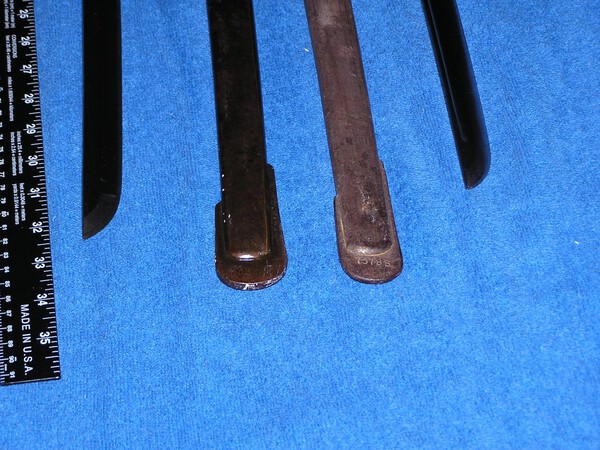-
Posts
256 -
Joined
-
Last visited
Content Type
Profiles
Forums
Events
Store
Downloads
Gallery
Everything posted by Austus
-
Somebody worked really hard to make this as close to new as possible, without having any idea that everything they did was wrong. Having it rewrapped without menuki tells of their limited knowledge, but also their hope. It is what is now, just try to enjoy it.
-
Which is what makes your collection a very important one. The specialty that you have chosen is one of proven top-tier cutters. Sure, they are elegant and beautiful. But they are incredibly efficient weapons, first. The sword world has much to learn from such tests. They're not doing them anymore. I'm surprised at the variations. Some are straight, some are curved, and 3 are even wakizashis. There doesn't seem to be any common element. Except that they are proven performers. The one thing we can't see from these nice photos is the geometry. That's the key. What makes for the best cutting profile? Maybe you should consider having them 3D scanned in the future. Maybe you could answer that question. Or even sell some of the repros. Once again. Gary, Thank You for taking our breath away.
-
Wow. Again. It's a real pleasure to see such fine examples of Nihonto. The lack of responses is a compliment in itself. What can you say about perfection? I would, however, plead for more information about these incredible specimens of yours. I am still learning this subject; and don't automatically know any of the finer points of such masterpieces. Anything you could mention would enhance everyone's knowledge. Thank You very much for sharing.
-
Missing the menuki and all the fittings have been aggressively cleaned. Painful to see. Bet the nakago is looks like the blade.
-
Another historically important beauty. What a collection... Thanks for sharing. Could I ask how long this sword is?
-

Ubu nihonto need help with identification
Austus replied to Utopianarian's topic in General Nihonto Related Discussion
George, your photoghraphic skills are far better than any that I aspire to. -
Welcome, Steffieee. The first thing you might want to do is read the Forum Posting Guidelines thread. Then bring it on!
-
Hey, Neil, I recognize that badge over his pocket; because it got me in trouble a while back, mixing it up with the infamous "W"stamp. On page 152 in Jim Dawson's book , it is said to be either an artillery officer (yellow badge) or a judge advocate (white badge). Your photo's badge looks pretty dark, though.
-
Thanks, Steve, that makes plenty of sense. As for cutting power, I'd hate to fight with one of these. Maybe from a running horse. And Hamfish, Thanks for showing the booklet Steve mentioned. Very Cool. I've yet to see that kind of tassel in person. And Kenny... Beware. Your new sword could spark a lifelong passion for Japanese swords. But you'll have plenty of company.
-
Well, Bruce, that was an interesting journey you sent me on. But embarrassing. No more working from memory for me! I can't get good enough pictures to show it, but the edge of my first one alternates in places from the grinders or whatever they used to sharpen them. The edge on the second one is a bit cleaner. But it turns out I have 2 ko swords. Matching numbers, #75,788 and #61,903. There are differences between them; but I won't bore you. The drags are different, showing both examples.
-
Yes, Steve, you are correct about the number being on the drag. Sorry, I was remembering those NCO swords. Would still be interested to hear if they match. Ever noticed the difference between the cutting edge of the ko and otsu? The ko has a zig-zag edge for cavalry use; and the otsu has a more expected straight edge, although a bit rough to improve slashing. The ko is point-heavy; whereas the otsu is much better balanced due to being shorter. Because the saya is brass lined, those blades are frequently super clean. But the steel is very soft, with no hamon. They were used for decades, so must have perforformed well enough.
-
Check and see if the numbers match. The scabbard should be numbered at the throat opening. If they match, end of story. Yours is missing the leather finger loop. Some of them were made without one. Look for a small hole in the D-guard and see if it's there or has been filled. Don't get any oil on that leather seppa, or it will disintegrate. Ask me how I know.
-

Ford Hallam has had a heart attack and is hospitalized
Austus replied to Jean's topic in General Nihonto Related Discussion
Great news. Somehow, I had no doubt that he would be okay. One of the unexpected bonuses of joining this site was being exposed to the genius of Ford Hallam. Am looking forward to many new creations in the future. Be Well! -
Thank You for sharing your stunning specimens. Please keep them coming.
-
What a fascinating image. I had to look him up (ashamed to say); and now I want to know more. But there are so many things going on here, it will be hard to get explanation locally for those dynamics: why some are purposely not watching, others appear to be bored; and it looks like there's another of the 47 ronin being guarded in the wings. His turn, next? Even if you could read Japanese, you would need a lot of historical knowledge to know who those dignitaries are, and what else is going on socially and politically. So much in just one image!
-

Literature about resistance tests on WW2 blades
Austus replied to Bruno's topic in Military Swords of Japan
Just clicked on that one, Bruce; and it's a really good discussion of niku and shinogi and other things affecting the dynamics of the cutting process. I'm fascinated with the modern approach to this ancient design; taking into account the different applications therein. We have better steel, and technology, and don't have to face armor anymore; so today's sword could be a completely different animal. But when you include the Art aspects; there comes a fork in the road. Ohmura also talked about the "science" of modern edge design and materials. He spoke highly of spring steel. He was talking about a weapon, first. -

Literature about resistance tests on WW2 blades
Austus replied to Bruno's topic in Military Swords of Japan
Bruno, if you haven't already read the Fuller & Gregory book "Japanese Military and Civil Swords and Dirks", there's an interesting discussion of the 9 different types of blade manufacturing methods being used before WW2. They are even ranked in quality by the authors, with traditionally made tamahagane blades on top. But no cutting comparisons. I went to the Ohmura site and read the difficult translation about the main types of pre-war methods and was very surprised at the opinion of the author toward traditional versus gunto blades. As I read it, he thinks gunto blades got a bad rep due to the stubborn traditionalists' disdain of any non-traditional methods. He does talk about cutting comparisons; and the guntos did real well. Maybe even better, in his examples. I recommend everyone read it; or at least try. -
Thanks, Dave and Bruce. Having fun with this mystery and learning. Don't know if it will help, but this is from Dawson's Cyclopedic Edition, page 207: "Civilian swords (katana and wakizashi) were carried by officers and enlisted men in the army and by gunzoku (uniformed civilian employees of the army). Civilian swords can be identified as having served a military function by their leather covered wooden scabbards. Sometimes those scabbards were made new for military use, and sometimes they were made from the old wood katana and wakizashi saya by adding a carrying ring and covering them with leather. The leather is an integral part of the scabbard and is not an optional combat cover. Suspension rings are fastened with either leather straps or metal bands fitted between the wood and leather of the scabbard. Swords are held in their scabbards by means of a leather tab and snap retention system mounted at the fuchi." The several examples shown had non-military fittings, including the menuki. One of them looked to have similar color ito and rayskin(?) as Neil's. But most of the leather covers had a triple-snap closure versus a laced closure like this one. And they all had a looped snap fixture on the tsuka; whereas this one has a seppa style attachment. Couple of other minor differences with the leather cover; but couldn't see the whole thing so never mind. Given all the differences found in the purely military swords, it could be hard to nail this one down. Nice specimen!
-
Good job, Bruce, as usual. Just an observation on this nice looking sword... I have never seen a Japanese sword without menukis.
-
Thanks, Neil, for the pic of that lovely blade! Looking forward to the rest of the story. This made me realize that koshirae is a lot like lingerie.
-
Is this a trick question, or just a tease? The leather cover would seem to point to a combat environment. What kind of saya? And can we please see the blade??
-

Literature about resistance tests on WW2 blades
Austus replied to Bruno's topic in Military Swords of Japan
Hey, Bruno. Hope you get lots of feedback on this thread. I, too, am very interested in the comparisons, if any. How about sharing what you have already foumd? -
How can 16 posts be too frequent? (Unless for commercial purposes.) Good pictures of quality pieces are enjoyable and educational for all. Bring it on!
-
Nobody mentioned NOT to touch the blade or clean anything. Just sayin'. Maybe a little oil? But not on the tang! Looking forward to the rest of the story!



